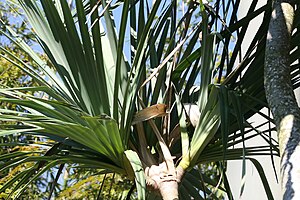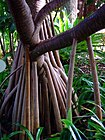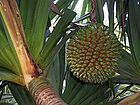Note: This is a project under development. The articles on this wiki are just being initiated and broadly incomplete. You can Help creating new pages.
Difference between revisions of "Pandanus utilis"
(Created page with "{{stub}} ==Uses== {{Uses|}}, {{Uses|}}, {{Uses|}}, {{Uses|}}, {{Uses|}}, {{Uses|}}, {{Uses|}}, {{Uses|}}, {{Uses|}}, {{Uses|}}, {{Uses|}}.<ref name="Uses"/> ==Parts Used== {{...") |
|||
| (2 intermediate revisions by 2 users not shown) | |||
| Line 1: | Line 1: | ||
| − | + | [[File:Pandanus utilis 28zz.jpg|thumb|right|'''Pandanus utilis''']] | |
| + | '''Pandanus utilis''' is the common screwpine is a monocot and not a pine. It is native to Madagascar and naturalised in Mauritius. | ||
==Uses== | ==Uses== | ||
| − | {{Uses| | + | {{Uses|Migraine}}. |
==Parts Used== | ==Parts Used== | ||
| − | {{Parts Used| | + | {{Parts Used|Leaves}}. |
==Chemical Composition== | ==Chemical Composition== | ||
| − | <ref name="chemical composition"/> | + | Utilis leaves, 19 compounds were obtained, consisting of seven triterpenoids (1-7), five steroids (8-12), four cyclohexenone derivatives (13-16), two benzenoid glycosides (17 and 18), and one lignan (19).<ref name="chemical composition"/> |
==Common names== | ==Common names== | ||
| − | {{Common names | + | {{Common names|kn=|ml=|sa=|ta=|te=|hi=|en=Bacona}} |
==Properties== | ==Properties== | ||
Reference: Dravya - Substance, Rasa - Taste, Guna - Qualities, Veerya - Potency, Vipaka - Post-digesion effect, Karma - Pharmacological activity, Prabhava - Therepeutics. | Reference: Dravya - Substance, Rasa - Taste, Guna - Qualities, Veerya - Potency, Vipaka - Post-digesion effect, Karma - Pharmacological activity, Prabhava - Therepeutics. | ||
===Dravya=== | ===Dravya=== | ||
| + | |||
===Rasa=== | ===Rasa=== | ||
| − | |||
===Guna=== | ===Guna=== | ||
| Line 29: | Line 30: | ||
==Habit== | ==Habit== | ||
| − | {{Habit|}} | + | {{Habit|Tree}} |
==Identification== | ==Identification== | ||
===Leaf=== | ===Leaf=== | ||
| − | {{Leaf|||}}<ref name="Leaf"/> | + | {{Leaf|Simple|Leaves arranged spirally in 3 series|crowded towards the top of stems, simple, without petiole but with broad clasping base}}<ref name="Leaf"/> |
===Flower=== | ===Flower=== | ||
| − | {{Flower||||}} | + | {{Flower|Unisexual||Cream white||Male flowers odorous, with 8–12 stamens inserted pseudo-umbellately on slender columnal excrescences 10–15 mm long; female flowers with 3–8-celled ovary crowned by a sessile stigma.}} |
===Fruit=== | ===Fruit=== | ||
| − | {{Fruit||| | + | {{Fruit|Simple|Dome-shaped, compressed, angular drupe arranged in a pendulous, long-peduncled|Subglobose syncarp 15–20 cm in diameter|}} |
===Other features=== | ===Other features=== | ||
| Line 46: | Line 47: | ||
==Where to get the saplings== | ==Where to get the saplings== | ||
| − | |||
==Mode of Propagation== | ==Mode of Propagation== | ||
| − | {{Propagation|}} | + | {{Propagation|Seeds}}. |
==How to plant/cultivate== | ==How to plant/cultivate== | ||
| − | <ref name="How to plant/cultivate"/> | + | Pandanus utilis can be propagated by seeds, but these are recalcitrant. Pre-soaking of the seeds for 24 hours before sowing is recommended for Pandanus in general.<ref name="How to plant/cultivate"/> |
==Commonly seen growing in areas== | ==Commonly seen growing in areas== | ||
| − | {{Commonly seen| | + | {{Commonly seen|Evergreen forest}}. |
==Photo Gallery== | ==Photo Gallery== | ||
<gallery class="left" caption="" widths="140px" heights="140px"> | <gallery class="left" caption="" widths="140px" heights="140px"> | ||
| + | File:Pandanus utilis 5zz.jpg | ||
| + | File:Pandanus utilis.jpg | ||
| + | File:Pandanus utilis 7zz.jpg | ||
| + | File:Pandanus utilis fruit.JPG | ||
</gallery> | </gallery> | ||
==References== | ==References== | ||
| + | |||
<references> | <references> | ||
| + | <ref name="chemical composition">[https://journals.sagepub.com/doi/pdf/10.1177/1934578X1601100209#:~:text=utilis%20leaves%2C%2019%20compounds%20were,and%20one%20lignan%20(19). Chemical composition]</ref> | ||
| − | <ref name=" | + | <ref name="Leaf">[https://uses.plantnet-project.org/en/Pandanus_utilis_(PROTA)#:~:text=Recorded%20medicinal%20uses%20are%20quite,forehead%20for%20the%20treatment%20of Morphology]</ref> |
| − | + | <ref name="How to plant/cultivate">[https://uses.plantnet-project.org/en/Pandanus_utilis_(PROTA)#:~:text=Recorded%20medicinal%20uses%20are%20quite,forehead%20for%20the%20treatment%20of Cultivation Details]</ref> | |
| − | |||
| − | <ref name="How to plant/cultivate">[ | ||
| − | |||
</references> | </references> | ||
==External Links== | ==External Links== | ||
| − | * [ ] | + | * [https://uses.plantnet-project.org/en/Pandanus_utilis_(PROTA)#:~:text=Recorded%20medicinal%20uses%20are%20quite,forehead%20for%20the%20treatment%20of Pandanus utilis on plantnet projects] |
| − | + | ||
| − | + | ||
[[Category:Herbs]] | [[Category:Herbs]] | ||
| + | [[Category:Pandanaceae]] | ||
Latest revision as of 16:43, 26 June 2020
Pandanus utilis is the common screwpine is a monocot and not a pine. It is native to Madagascar and naturalised in Mauritius.
Contents
- 1 Uses
- 2 Parts Used
- 3 Chemical Composition
- 4 Common names
- 5 Properties
- 6 Habit
- 7 Identification
- 8 List of Ayurvedic medicine in which the herb is used
- 9 Where to get the saplings
- 10 Mode of Propagation
- 11 How to plant/cultivate
- 12 Commonly seen growing in areas
- 13 Photo Gallery
- 14 References
- 15 External Links
Uses
Parts Used
Chemical Composition
Utilis leaves, 19 compounds were obtained, consisting of seven triterpenoids (1-7), five steroids (8-12), four cyclohexenone derivatives (13-16), two benzenoid glycosides (17 and 18), and one lignan (19).[1]
Common names
| Language | Common name |
|---|---|
| Kannada | |
| Hindi | |
| Malayalam | |
| Tamil | |
| Telugu | |
| Marathi | NA |
| Gujarathi | NA |
| Punjabi | NA |
| Kashmiri | NA |
| Sanskrit | |
| English | Bacona |
Properties
Reference: Dravya - Substance, Rasa - Taste, Guna - Qualities, Veerya - Potency, Vipaka - Post-digesion effect, Karma - Pharmacological activity, Prabhava - Therepeutics.
Dravya
Rasa
Guna
Veerya
Vipaka
Karma
Prabhava
Habit
Identification
Leaf
| Kind | Shape | Feature |
|---|---|---|
| Simple | Leaves arranged spirally in 3 series | crowded towards the top of stems, simple, without petiole but with broad clasping base |
Flower
| Type | Size | Color and composition | Stamen | More information |
|---|---|---|---|---|
| Unisexual | Cream white | Male flowers odorous, with 8–12 stamens inserted pseudo-umbellately on slender columnal excrescences 10–15 mm long; female flowers with 3–8-celled ovary crowned by a sessile stigma. |
Fruit
| Type | Size | Mass | Appearance | Seeds | More information |
|---|---|---|---|---|---|
| Simple | Dome-shaped, compressed, angular drupe arranged in a pendulous, long-peduncled | Subglobose syncarp 15–20 cm in diameter | {{{5}}} | {{{6}}} |
Other features
List of Ayurvedic medicine in which the herb is used
Where to get the saplings
Mode of Propagation
How to plant/cultivate
Pandanus utilis can be propagated by seeds, but these are recalcitrant. Pre-soaking of the seeds for 24 hours before sowing is recommended for Pandanus in general.[3]




